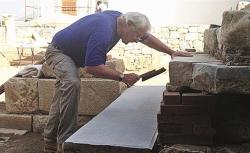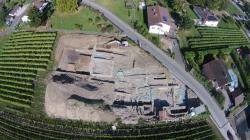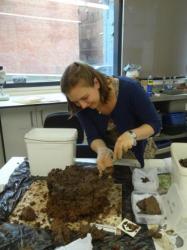INSTITUT SUPERIEUR D'ANTHROPOLOGIE
INSTITUTE OF ANTHROPOLOGY
ONLINE COURSES / COURS A DISTANCE
WINTER TERM : JANUARY 2015
REGISTER NOW
TURQUIE –  Hecatomnus Mausoleum - Excavations around the Hecatomnus Mausoleum in the western province of Muğla’s Milas district hasve unearthed a written stela that dates back over two millennia.The stela is an extraordinary finding that offers very important data to historians and philologists, according to academics. The stela, which is estimated to have been written for the ruler of its era, is in the poetry format and the longest among other similar classical-era findings. According to information provided by the Milas Uzunyuva Project Epigraph Professor Christian Marek, the writing on the stela has a poetical language in a style called “catalectic trochaic tetrameter.” There are 121 lines in the stela, although its upper surface has been eroded. It is estimated that the stela was erected at the end of fourth century B.C. or at the beginning of the third century B.C.
Hecatomnus Mausoleum - Excavations around the Hecatomnus Mausoleum in the western province of Muğla’s Milas district hasve unearthed a written stela that dates back over two millennia.The stela is an extraordinary finding that offers very important data to historians and philologists, according to academics. The stela, which is estimated to have been written for the ruler of its era, is in the poetry format and the longest among other similar classical-era findings. According to information provided by the Milas Uzunyuva Project Epigraph Professor Christian Marek, the writing on the stela has a poetical language in a style called “catalectic trochaic tetrameter.” There are 121 lines in the stela, although its upper surface has been eroded. It is estimated that the stela was erected at the end of fourth century B.C. or at the beginning of the third century B.C.
http://www.hurriyetdailynews.com/longest-poem-of-classical-era-unearthed-in-western-turkey.aspx?pageID=238&nID=73190&NewsCatID=375
SUISSE –  Saint Prex - Le chantier de construction d'une villa jumelle, à Saint-Prex, a révélé un important vestige archéologique. Une villa datant de l'époque romaine (entre le Ier et le IVe siècle après J.-C.) se cachait sous une parcelle viticole située en bordure de la route de Lussy. «Nous connaissions l'existence d'un tel établissement à Saint-Prex, mais nous ignorions où il se situait exactement», explique Nicole Pousaz, archéologue cantonale, confirmant l'information parue dans La Côte. La parcelle a été passée au peigne fin ces dernières semaines et les premiers résultats devraient paraître prochainement.
Saint Prex - Le chantier de construction d'une villa jumelle, à Saint-Prex, a révélé un important vestige archéologique. Une villa datant de l'époque romaine (entre le Ier et le IVe siècle après J.-C.) se cachait sous une parcelle viticole située en bordure de la route de Lussy. «Nous connaissions l'existence d'un tel établissement à Saint-Prex, mais nous ignorions où il se situait exactement», explique Nicole Pousaz, archéologue cantonale, confirmant l'information parue dans La Côte. La parcelle a été passée au peigne fin ces dernières semaines et les premiers résultats devraient paraître prochainement.
http://www.24heures.ch/vaud-regions/la-cote/Une-villa-romaine-refait-surface-a-SaintPrex/story/19048701
MACEDONIE –  The most valuable artifacts of Macedonia’s cultural heritage will be displayed in the new Archaeological Museum of Macedonia, which will formally open on Saturday evening. More than 6,000 artifacts from all historical periods, beginning from prehistoric times up to the Middle Ages will be displayed on three floors spanning 6,000 m2. The Museum is divided in several departments – prehistoric archaeology, antique and medieval archaeology, numismatic cabinet, lapidarium, anthropological display etc. Moreover, it includes 15 wax figures, 83 paintings, video-animations, ambience displays, mosaics, reconstruction of neolithic buildings.
The most valuable artifacts of Macedonia’s cultural heritage will be displayed in the new Archaeological Museum of Macedonia, which will formally open on Saturday evening. More than 6,000 artifacts from all historical periods, beginning from prehistoric times up to the Middle Ages will be displayed on three floors spanning 6,000 m2. The Museum is divided in several departments – prehistoric archaeology, antique and medieval archaeology, numismatic cabinet, lapidarium, anthropological display etc. Moreover, it includes 15 wax figures, 83 paintings, video-animations, ambience displays, mosaics, reconstruction of neolithic buildings.
http://macedoniaonline.eu/content/view/26268/45/
ROYAUME UNI –  Worcester - The finds and environmental team of the Archive and Archaeology Service were tasked with examining the pot — which dates back to the Iron Age — after it was found at a site owned by Wychavon District Council. The team were brought the pot housed within a block of soil by Sean Cook, from One Ten Archaeology, who works with construction companies to handle and preserve any potential artefacts found during building work. They also discovered evidence of pollen on the base of the pot, and the type of pollen grains found suggest that it may have once contained honey. Derek Hurst, senior archaeological project manager said: "During the Iron Age, honey would have been one of the few sweeteners available to people, as sugar hadn't arrived in Britain at that point. Honey was also used to make alcoholic drinks, such as mead, and it was used in offerings too. "Exactly what the pot was being used for is likely to remain a mystery, but it has given us an insight into ancient culinary habits and the fact that it was deliberately set into the ground suggests a ritual use. "Although the finds and environment team spend the majority of their time on internal projects, we do also take in external work and the investigation was funded by Rooftop Housing." The team found that the pot and other sherds of pottery came from the late Iron Age, a period that is poorly represented in Worcestershire.
Worcester - The finds and environmental team of the Archive and Archaeology Service were tasked with examining the pot — which dates back to the Iron Age — after it was found at a site owned by Wychavon District Council. The team were brought the pot housed within a block of soil by Sean Cook, from One Ten Archaeology, who works with construction companies to handle and preserve any potential artefacts found during building work. They also discovered evidence of pollen on the base of the pot, and the type of pollen grains found suggest that it may have once contained honey. Derek Hurst, senior archaeological project manager said: "During the Iron Age, honey would have been one of the few sweeteners available to people, as sugar hadn't arrived in Britain at that point. Honey was also used to make alcoholic drinks, such as mead, and it was used in offerings too. "Exactly what the pot was being used for is likely to remain a mystery, but it has given us an insight into ancient culinary habits and the fact that it was deliberately set into the ground suggests a ritual use. "Although the finds and environment team spend the majority of their time on internal projects, we do also take in external work and the investigation was funded by Rooftop Housing." The team found that the pot and other sherds of pottery came from the late Iron Age, a period that is poorly represented in Worcestershire.
http://www.worcesternews.co.uk/news/11543606.Archaeologists_make_sweet_discovery_in_Worcestershire_village/
USA –  Bellville - For Nigel Brush, the Ashland University professor leading the excavation, it was among the most exciting discoveries of his career. Mastodon remains have been found in Ohio before, but they are usually incomplete — a tooth, or a bit of tusk. A full or almost-full skeleton would be rare. “I’ve been waiting a couple of decades for a call like that,” Brush said during a recent Saturday at the excavation site. “It has the potential to be special.” It has even more potential to be special because of the things the scientists are finding around the bones. The bones mostly have been discovered on piles of rocks and gravel. The researchers have found bits of flint and lines of charcoal, too. The soybean field leads to a bog, which the scientists say probably existed back in the Ice Age when it likely was a little bit bigger — maybe the size of a small lake. All the evidence leads Brush to believe that Ice Age hunters chased this mastodon across the field, trapped it on the uneven wet ground near the lake, and then killed it, cleaned it on those rock piles and cooked the meat right there.
Bellville - For Nigel Brush, the Ashland University professor leading the excavation, it was among the most exciting discoveries of his career. Mastodon remains have been found in Ohio before, but they are usually incomplete — a tooth, or a bit of tusk. A full or almost-full skeleton would be rare. “I’ve been waiting a couple of decades for a call like that,” Brush said during a recent Saturday at the excavation site. “It has the potential to be special.” It has even more potential to be special because of the things the scientists are finding around the bones. The bones mostly have been discovered on piles of rocks and gravel. The researchers have found bits of flint and lines of charcoal, too. The soybean field leads to a bog, which the scientists say probably existed back in the Ice Age when it likely was a little bit bigger — maybe the size of a small lake. All the evidence leads Brush to believe that Ice Age hunters chased this mastodon across the field, trapped it on the uneven wet ground near the lake, and then killed it, cleaned it on those rock piles and cooked the meat right there.
http://www.dispatch.com/content/stories/local/2014/10/19/buried-treasure.html
ROYAUME UNI –  Lincoln - Excavations at the new Bomber Command Centre on the outskirts of Lincoln have revealed artefacts dating back to Roman times. Bomber Command Centre director Nicky Barr said: "We found Roman artefacts including a section of wall and it is that which we are excavating. The evidence suggested that in the Roman period, people were living at the site and quarrying the local limestone, which is very near to the surface on that site, for buildings in the city. The remains of collapsed stone buildings were also recorded on the site, suggesting that the community who were quarrying the local stone were living on the site.
Lincoln - Excavations at the new Bomber Command Centre on the outskirts of Lincoln have revealed artefacts dating back to Roman times. Bomber Command Centre director Nicky Barr said: "We found Roman artefacts including a section of wall and it is that which we are excavating. The evidence suggested that in the Roman period, people were living at the site and quarrying the local limestone, which is very near to the surface on that site, for buildings in the city. The remains of collapsed stone buildings were also recorded on the site, suggesting that the community who were quarrying the local stone were living on the site.
http://www.lincolnshireecho.co.uk/Archaeologists-Roman-artefacts-Lincoln-Bomber/story-23196878-detail/story.html